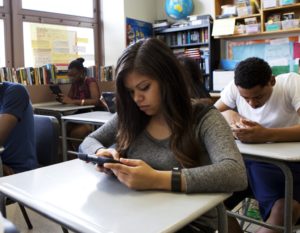

Here are five quick ways to determine if students are really owning their own learning:
- Increased Stamina and Focus: Engaged students reading on level will read approximately 2 minutes per page and may sit for long periods of time without looking up. But don’t be completely fooled by the student who is sitting upright, has his eyes moving across the page, and looks to be turning pages at an appropriate rate. Silent reading time is a notoriously easy time for students to go under the radar and just look like they are reading.
- Not there yet? Praise students when they make small strides in stamina, put students into small groups to make reading a more communal experience, and set concrete and measurable goals with students.
- Digital platforms make it particularly easy to catch fake readers. With teacher alerts when students haven’t read, in-text assessments that provide real-time comprehension data, and metrics about time-on-task, it becomes much easier to redirect students.
- Engaged Body Language: During silent reading, engaged students lean into their books, and their facial expressions reflect what they are reading. It’s as if they are oblivious to the world around them, and their faces reflect the experiences in the characters of the book. If you’ve ever seen a child read Matilda and get to the scene where she moves the chalk with her eyes for the first time or a student read as Jonas in The Giver sees in color for the first time, you’ve seen that look!
- Not there yet? Help students find just right books for their interests and reading levels. Research shows that time spent reading in a student’s zone of proximal development will lead to the greatest growth, and allowing students to choose within that parameter honors student opinion.
- Digital libraries can help automate the processes of leveling libraries and getting appropriately complex texts in students hands!
- Comments Showing Pride: Engaged students talk about their work differently. There’s a level of pride in accomplishment, whether it’s talking about moving to a new reading level, wanting to share something they’ve written, or discussing how they overcame an obstacle.
- Not there yet? In my classroom, I had a U-Rock (“You rock!”), which was literally a rock with a U written on it. Students knew they had a reason to be proud when they saw that U-Rock on their desks, but it was up to them to declare to the class what that something was. By having students determine the reason to be proud rather than me telling them why they had earned the U-Rock, we set in motions mindsets of pride.
- Digital platforms can help build pride in an immediate way. From digital badges to visualizations of growth to automated portfolios, students have reasons to be proud right at their fingertips.
- Deeper Levels of Conversation – Students going through the motions talk about what happened in a book, but a classroom full of engaged student debates and discusses, eagerly looking through texts to prove their points.
- Not there yet? Have all students respond to the same question, and then, instead of reading responses out loud or asking students to share out, pick one for students to debate. Alternatively, try a fishbowl-style conversation, with several students discussing a plot point while other students circle around and listen. Then have students swap spots and continue where the conversation left off.
- With digital, the conversation can happen asynchronously, so students can be engaged in fierce debate by messaging back and forth, making face-to-face conversations even more lively. Alternatively, digital can make a fishbowl experience even more lively, as students listening on the outside can still participate in the conversation by posting their thoughts
- Requesting More Reading Time: Engaged students sigh when it’s time to wrap up reading. Students ask for “five more minutes” to wrap up a book club conversation, request to stay in during lunch to read, and ask if they can take their books home.
- Not there yet? Make reading time sacred and special. Let students read on top of their desks, in a cozy chair, or sprawled across the floor.
- When you’ve gone digital, you no longer need a place for a physical library, so use that space to build a comfortable reading zone! Plus, when books live in the cloud, students can access them anytime, anywhere.
Want to share what engagement looks like in your classroom? Tweet us your ideas @lightsailed to continue the conversation!
Guthrie, J. T. (2004). Teaching for literacy engagement. Journal of Literacy Research, 36(1), 1-28.
Posted on 2.Feb.16 in Literacy Strategies




